This window shows a summary of the data acquisition
parameters for each channel (the physical A to D input, the A,
B, and C (exponent if power function) values for voltage conversion, the
Y-axis scaling, the number of readings averaged, and the channel label).
To alter any of these parameters, click the cursor in the appropriate edit
field and change the parameter as desired. This example for
Chart mode shows seven input channels:

- In Oscilloscope and Oscilloscope plus Chart mode, some
edit fields are 'fixed' and cannot be changed. These have
a dark gray background.
- A channel used for the keyboard event recorder must have
an A value of -9999. The B and C values are not used.
- The A, B, and C values for a 3-order polynomial are replaced by a button, as seen here for channel 7. Click this to change
polynomial variables.
NOTE: If you load a setup file that was (a) made for a different A-D converter than the one in use, and (b) one or more of the hardware A-D input assignments in the setup file are outside of the range of A-D inputs on the current A-D converter (for example, the A-D converter you are using has 12 inputs and some of the assignments are for inputs 13, 14, 15, or 16), the following window appears:
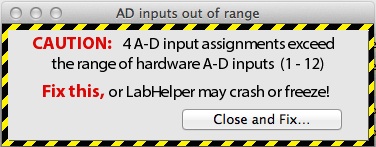
Either delete the offending channels, or change their A-D inputs to values within the scope of the A-D converter in use. If you don't, there is an excellent chance the program will 'lock up' (freeze) when it tries to read data from nonexistent hardware.
Top of page
The
CONVERSIONS menu lets you use the
regular voltage Conversions window to
adjust the voltage conversion parameters on each channel (except for oscilloscope
channels, which read raw input voltage only). You can also access
the set alarms window to configure an appropriate alarm setup (see
the MENU section for details).
To test
the voltage conversion and display parameters for any channel, click the
appropriate "Ch. #" button in the leftmost column.
A window will open showing a scrolling display of the current input values
on the selected channel:
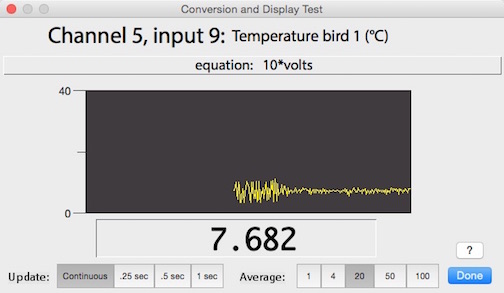
This will allow you to adjust any voltage offsets, gains, etc. before starting a data acquisition run. You can switch between fast and slow updating by pushing the 'update' buttons (slow updating is sometimes more readable), and you can adjust the number of averaged samples per update with the 'average' buttons.
In this example, sampling began at a low averaging number (1) and then the user raised the averaging number to 20 -- resulting in a much 'smoother' plot.
CAUTION: With slow A-D converters, such as the ADAM units and some DataTakers (DT50, 500, or 600), response to button clicks may be delayed and the update rate may be very slow if you select a high averaging number.
Top of page
In Chart
mode, Scope plus Chart mode, or Multichannel Oscilloscope mode,
you can add or delete channels with buttons in the lower left corner.
This example shows three channels being removed from a 9-channel setup:
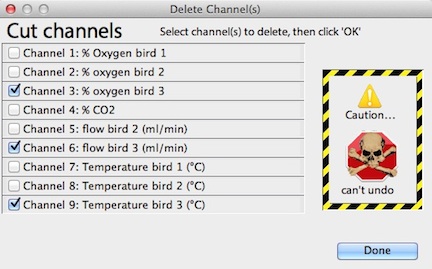
You cannot add beyond 16 channels in Chart mode (5 in Scope
plus Chart mode), and (obviously) you cannot cut to less than 1 channel in Chart
mode (2 in Scope plus Chart mode).
You
may also change the sample interval (both
the oscilloscope and chart channel intervals can be changed if you are in
Oscilloscope plus Chart mode), the control of external
devices, set up triggering, or
restart LabHelper (this is useful if you want to load
a setup file, or change the recording mode).
Top of page
The
'Chart View...' button opens a window that allows selection of
the 'density' of data plotted in chart mode:
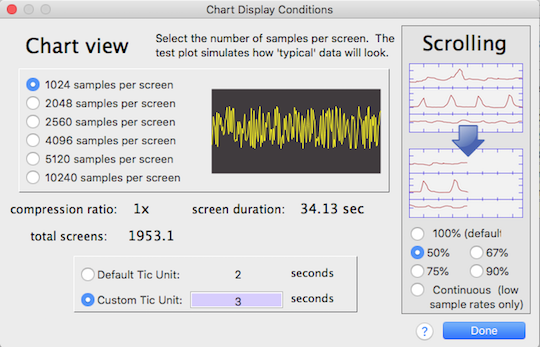
The normal view contains
one sample per pixel on the x-axis. However, you can select compression
ratios of 2, 2.5, 4, 5, and 10 (these options are available only if the
number of chart samples is greater than the number of samples per screen).
Thus with a 640-pixel-wide screen, up to 6400 samples can be shown on a
single screen. The range is 832 - 8320 when using an 832 pixel-wide
screen, and so forth with larger screen sizes.
Using the more compressed views increases the amount of recording time
that fits on the screen, but at the same time the screen resolution is decreased
(for viewing only; not recording) because several samples are plotted within
the same x-axis pixel position.
Some combinations of view compression and maximum sample number may generate
fractional time units on the X-axis of the chart display. However,
you can manually adjust the scaling of the 'time tics' on the x-axis (if
they are used) with the 'custom tic unit' button.
If the number of samples is greater than can be shown on a single screen,
the chart display must be scrolled when the data plot reaches the
screen's right edge. The default scrolling value is 100% -- that is,
the entire screen is redrawn, showing none of the previously-acquired data.
Alternately you may select fractional scrolling (50%, 67%, or 75%), which
leaves some of the previously-acquired data in view.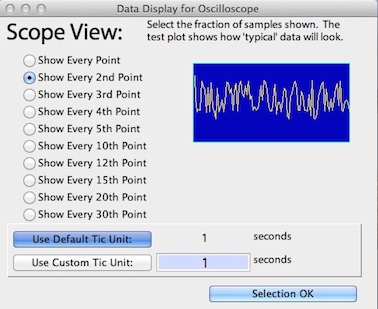
The 'Scope View...' button opens a window that allows selection of
the 'density' of data plotted in scope mode. It is similar to Chart
View, except that it offers options to show only a fraction of the gathered
data (all will be saved if a file is stored). This can increase
the display rate and hence the fraction of total time spent in sampling
data (however, it's of little use with slow A-D converters).
Note that you should use the "show every point"
option UNLESS you don't need to see every display point:
Top of page
The 'Screen View...' button lets you
divide the screen up among the different channels according to your own
preferences. For example, you can show some channels in large vertical
scale and others in much smaller scale. 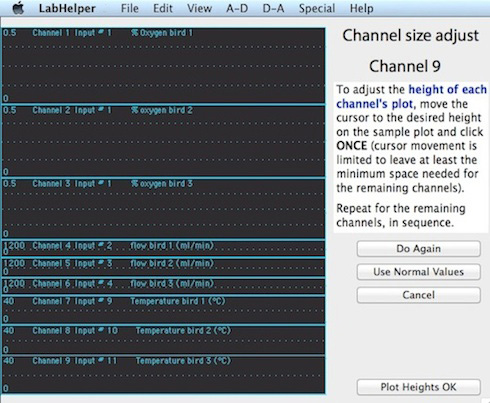 Note that because there is
a fixed amount of screen space available, making a channel larger than normal
requires shrinkage of other channels: Note that because there is
a fixed amount of screen space available, making a channel larger than normal
requires shrinkage of other channels:
To set channel heights, move the cursor within the simulated plot area
until it is at the desired height, then click. The program steps through
the channels in sequence. When all channels are complete, you can
accept the results, use normal values (all channels with equal heights),
or redo the selection. The program always reserves a minimum amount
of space for any remaining channels (20 pixels high). Channel heights
do not affect other aspects of the data acquisition process.
Top of page
At the bottom of the Acquisition parameters screen are buttons to select:
The
maximum number of samples to be gathered in chart mode before LabHelper
stops to save the recorded information. The
value can be incremented in units of screenwidth pixels up to the maximum of two million. These
buttons are not available in Oscilloscope mode.
The
number of samples in a scope screen (in Oscilloscope or Oscilloscope plus
Chart mode). The choices are 640 up
to 65,500 (depending on the size of the screen). The value can be
incremented in units of 640, 832, etc. depending on screen width.
These buttons are not available in Chart mode.
Whether
or not the computer beeps at each sample (not available in Oscilloscope
mode, or at high sampling rates in other modes).
The
AUTOREPEAT option. Autorepeat (Chart mode
only) instructs LabHelper to automatically save data when the maximum
number of samples has been recorded, and then automatically restart acquisition. If this option is selected, a standard Mac file opening
dialog will appear, requesting a file root name. Saved files will
have a name consisting of the root (e.g., 'bird data') plus a suffix corresponding
to the sequence number (e.g., 'bird data 1', then 'bird data 2', then 'bird
data 3', etc.).
WARNING: if you selected
a large number of samples, be sure you have plenty of disk space available
to save the expected number of files! |
After the file root is selected, LabHelper presents a window for
entering a comment string and data for gas exchange calculations (body mass,
flow rate, barometric pressure, etc.).
If you are in Oscilloscope plus Chart mode, a button for Automatic
markers is displayed at the bottom left of the screen. If this
button is ON, LabHelper will insert a marker into the chart files
whenever an oscilloscope screen is saved. These markers are a sequence
of numbers from 0 to 9, which repeats up to a total of several thousand markers.
You can also enter markers manually by pushing any letter or number key.
Edit
these values as necessary and
click the 'Setup OK' button.
|

 Note that because there is
a fixed amount of screen space available, making a channel larger than normal
requires shrinkage of other channels:
Note that because there is
a fixed amount of screen space available, making a channel larger than normal
requires shrinkage of other channels: